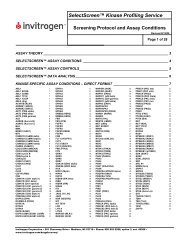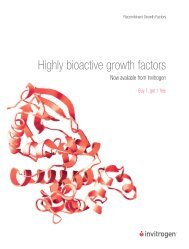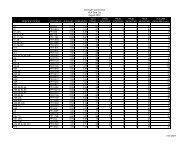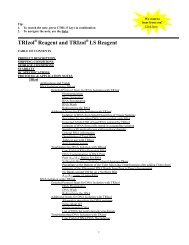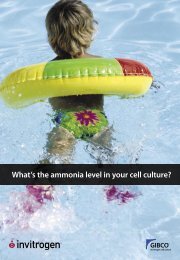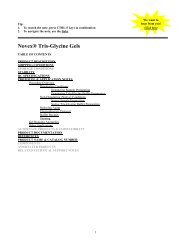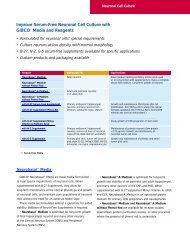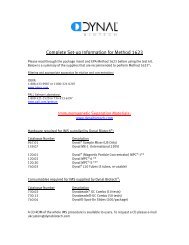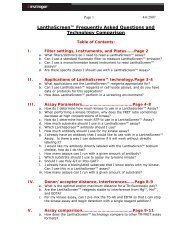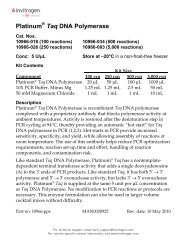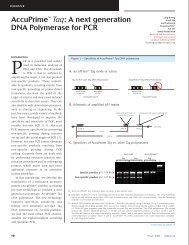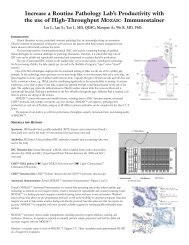Summary of Health and Safety Test Results - Invitrogen
Summary of Health and Safety Test Results - Invitrogen
Summary of Health and Safety Test Results - Invitrogen
You also want an ePaper? Increase the reach of your titles
YUMPU automatically turns print PDFs into web optimized ePapers that Google loves.
<strong>Summary</strong> <strong>of</strong> <strong>Health</strong> <strong>and</strong> <strong>Safety</strong> <strong>Test</strong> <strong>Results</strong><br />
SYBR Safe DNA Gel Stain
2<br />
Mens Sana in Corpore Sano.<br />
(translation: A healthy mind in a healthy body.)<br />
SYBR Safe DNA gel stain promotes safety by removing a<br />
known health hazard—ethidium bromide—from your lab.<br />
Ethidium bromide is so commonplace in molecular biology labs<br />
that it’s easy to forget how hazardous it is. However, ethidium<br />
bromide is a known carcinogen <strong>and</strong> a powerful mutagen,<br />
making it both a health hazard <strong>and</strong> a disposal headache. There<br />
has long been a need for a safer nucleic acid gel stain, <strong>and</strong> now<br />
it’s here. Specifi cally developed to enhance lab safety without<br />
compromising staining performance, SYBR Safe DNA gel stain<br />
is less mutagenic, less toxic, more environmentally friendly, <strong>and</strong><br />
it works with traditional gel staining methods.<br />
Further Information<br />
SYBR Safe DNA gel stain provides:<br />
n <strong>Safety</strong>—Less mutagenic than ethidium bromide;<br />
tests negative for genotoxicity <strong>and</strong> acute oral toxicity<br />
(LD 50 >5000 mg/kg)<br />
n Low Environmental Impact—Not classifi ed as a hazardous<br />
waste; meets the requirements <strong>of</strong> the Clean Water Act<br />
n Sensitivity—Uncompromised detection sensitivity as com-<br />
pared to ethidium bromide<br />
n Convenience—Provided as a concentrate or as a ready-to-use<br />
solution in TBE or TAE buff er; can be precast in gels or used as<br />
a post-stain<br />
n Speed—No destaining required; can be cast directly in the gel<br />
n Compatibility—Use with a st<strong>and</strong>ard UV epi- or trans-<br />
illuminator, a visible-light transilluminator, or a laser-based<br />
scanner<br />
This document is intended to present a brief summary <strong>of</strong> the safety <strong>and</strong> environmental data<br />
gathered so far about our SYBR Safe DNA gel stain. Further information—including detailed<br />
performance <strong>and</strong> safety results—can be accessed at probes.invitrogen.com/sybrsafe.<br />
We want to help you solve your disposal problems.<br />
If your local disposal agencies require additional<br />
tests or data, please let us know by sending an<br />
e-mail to sybrsafe@invitrogen.com.<br />
Important Licensing Information<br />
These products may be covered by one or more Limited Use Label Licenses (see the <strong>Invitrogen</strong> website,<br />
www.invitrogen.com, or the Molecular Probes website, probes.invitrogen.com). By use <strong>of</strong> these products<br />
you accept the terms <strong>and</strong> conditions <strong>of</strong> all applicable Limited Use Label Licenses. All products are for<br />
research use only. CAUTION: Not intended for human or animal diagnostic or therapeutic uses.
Feeling Lucky?<br />
Overview <strong>of</strong> SYBR Safe <strong>Test</strong> <strong>Results</strong><br />
SYBR Safe DNA gel stain does not induce transformations in<br />
primary cultures <strong>of</strong> Syrian hamster embryo (SHE) cells when<br />
compared with solvent alone, strongly indicating that the SYBR<br />
Safe stain is noncarcinogenic. In contrast, ethidium bromide<br />
tests positive in the SHE assay, consistent with its known activity<br />
as a strong mutagen.<br />
SYBR Safe DNA gel stain does not cause mutations in<br />
mouse lymphoma cells at the TK locus, nor does it induce<br />
chromosomal aberrations in cultured human peripheral blood<br />
lymphocytes, with or without S9 metabolic activation, using<br />
st<strong>and</strong>ardized tests against appropriate controls.<br />
Important Licensing Information<br />
These products may be covered by one or more Limited Use Label Licenses (see the <strong>Invitrogen</strong> website,<br />
www.invitrogen.com, or the Molecular Probes website, probes.invitrogen.com). By use <strong>of</strong> these products<br />
you accept the terms <strong>and</strong> conditions <strong>of</strong> all applicable Limited Use Label Licenses. All products are for<br />
research use only. CAUTION: Not intended for human or animal diagnostic or therapeutic uses.<br />
SYBR Safe DNA Gel Stain<br />
Compared to ethidium bromide, SYBR Safe DNA gel stain<br />
causes fewer mutations in the st<strong>and</strong>ard Ames test, as mea-<br />
sured in several diff erent strains <strong>of</strong> Salmonella typhimurium.<br />
Weakly positive results for SYBR Safe DNA gel stain in this test<br />
occurred in four out <strong>of</strong> seven strains <strong>and</strong> only with activation by<br />
a mammalian S9 fraction.<br />
A single oral administration <strong>of</strong> SYBR Safe DNA gel stain<br />
produces no signs <strong>of</strong> mortality or toxicity at a limit dose <strong>of</strong><br />
5000 mg/kg.<br />
Based on extensive environmental safety testing, SYBR Safe<br />
DNA gel stain is not classifi ed as hazardous waste under U.S.<br />
Federal regulations (Resource Conservation <strong>and</strong> Recovery Act<br />
(RCRA)). SYBR Safe DNA gel stain meets the requirements<br />
<strong>of</strong> the Clean Water Act <strong>and</strong> the National Pollutant Discharge<br />
Elimination System (NPDES) requirements.<br />
w w w.invitrogen.com | probes.invitrogen.com<br />
3
4<br />
Born to Be Wild-Type.<br />
Genotoxicity <strong>Results</strong><br />
Conclusion<br />
SYBR Safe DNA gel stain does not induce transformations in<br />
primary cultures <strong>of</strong> Syrian hamster embryo (SHE) cells when<br />
compared with solvent alone, strongly indicating that the SYBR<br />
Safe stain is noncarcinogenic. In contrast, ethidium bromide<br />
tests positive in the SHE assay, consistent with its known activity<br />
as a strong mutagen.<br />
<strong>Summary</strong> <strong>of</strong> <strong>Results</strong><br />
An independent laboratory investigated the ability <strong>of</strong><br />
SYBR Safe DNA stain for inducing an increase in morpho-<br />
logical transformation <strong>of</strong> Syrian hamster embryo (SHE) cells,<br />
relative to vehicle control cultures, following a 7-day exposure<br />
period. None <strong>of</strong> the three treatment groups (0.0500, 0.150, <strong>and</strong><br />
0.300 μg/ml) induced a signifi cant increase in morphological<br />
transformation compared to the concurrent vehicle control. In<br />
addition, a signifi cant increase <strong>of</strong> the morphological transfor-<br />
mation frequency was also obtained from the positive control<br />
treatment with benzo α pyrene at 5.0 mg/ml. The test article<br />
(SYBR Safe stain) was therefore evaluated as negative in the<br />
screening SHE cell transformation assay under 7-day exposure<br />
conditions <strong>of</strong> this study.<br />
Table 1. SYBR Safe stain—Mammalian genotoxicity analysis<br />
Conclusion<br />
SYBR Safe DNA gel stain does not cause mutations in mouse<br />
lymphoma cells at the TK locus, nor does it induce chro-<br />
mosomal aberrations in cultured human peripheral blood<br />
lymphocytes, with or without S9 metabolic activation, using<br />
st<strong>and</strong>ardized tests against appropriate controls.<br />
<strong>Summary</strong> <strong>of</strong> <strong>Results</strong><br />
An independent laboratory investigated the ability <strong>of</strong><br />
SYBR Safe DNA gel stain to induce chromosomal aberrations<br />
in cultured peripheral blood lymphocytes with <strong>and</strong> without<br />
exogenous metabolic activation. No signifi cant increases in<br />
the number <strong>of</strong> cells with structural aberrations, polyploidy, or<br />
endoreduplication were observed in test either with or without<br />
S9 activation. Similarly, no increases in the mutant frequency<br />
were observed that exceeded the minimum criteria in L5178Y<br />
TK+/- mouse lymphoma cells.<br />
In In In Vitro Vitro Vitro <strong>Test</strong> * Cell Type Result with S9 Activation † Result without S9 Activation †<br />
Transformation 1 Syrian hamster embryo (SHE) cells NA Negative<br />
Chromosomal aberrations 2 Cultured human peripheral blood lymphocytes Negative Negative<br />
Forward mutation 3,4 L5178YTK+/- mouse lymphoma cells Negative Negative<br />
* In vitro tests were performed by Covance Laboratories Inc., Vienna, VA. † Mammalian S9 fraction obtained from Aroclor 1254–induced rat liver.<br />
NA = Not applicable.<br />
1. Fundamental <strong>and</strong> Molecular Mechanisms <strong>of</strong> Mutagenesis 356, 1 (1996); 2. Evans, H.J., in Chemical Mutagens, Principles <strong>and</strong> Methods for Their Detection,<br />
A. Hollaender, Ed., Vol. 4, (1976) pp. 1–29; 3. Mutation Res 72, 447 (1980); 4. Mutation Res 59, 61 (1979).<br />
Important Licensing Information<br />
These products may be covered by one or more Limited Use Label Licenses (see the <strong>Invitrogen</strong> website,<br />
www.invitrogen.com, or the Molecular Probes website, probes.invitrogen.com). By use <strong>of</strong> these products<br />
you accept the terms <strong>and</strong> conditions <strong>of</strong> all applicable Limited Use Label Licenses. All products are for<br />
research use only. CAUTION: Not intended for human or animal diagnostic or therapeutic uses.
Conclusion<br />
Compared to ethidium bromide, SYBR Safe DNA gel stain<br />
causes fewer mutations in the st<strong>and</strong>ard Ames test, as mea-<br />
sured in several diff erent strains <strong>of</strong> Salmonella typhimurium.<br />
Weakly positive results for SYBR Safe DNA gel stain in this test<br />
occurred in four out <strong>of</strong> seven strains <strong>and</strong> only with activation by<br />
a mammalian S9 fraction (see fi gure).<br />
<strong>Summary</strong> <strong>of</strong> <strong>Results</strong><br />
Samples were pretreated with a mammalian S9 fraction <strong>and</strong><br />
then tested. With S. S. S. typhimurium typhimurium typhimurium strains TA97a, TA98, TA100<br />
<strong>and</strong> TA102, an increase in revertants <strong>of</strong> more than tw<strong>of</strong>old over<br />
background indicates a positive result for mutagenicity in this<br />
test. With strains TA1535, TA1537 <strong>and</strong> TA1538, an increase in<br />
revertants <strong>of</strong> more than threefold over background indicates a<br />
positive result.<br />
We Like You Just the Way You Are.<br />
Toxicity <strong>Results</strong><br />
Conclusion<br />
A single oral administration <strong>of</strong> SYBR Safe DNA gel stain produces<br />
no signs <strong>of</strong> mortality or toxicity at a limit dose <strong>of</strong> 5000 mg/kg.<br />
Table 2. SYBR Safe stain—Toxicity analysis<br />
Analysis Method <strong>Results</strong><br />
Aquatic toxicity * Fathead minnow<br />
CA Title 22 acute screening<br />
Oral toxicity ** EPA Acute Oral Toxicity <strong>Test</strong><br />
OPPTS 870.1100<br />
Not hazardous or toxic<br />
to aquatic life<br />
LD50 > 5000 mg/kg<br />
* Performed by AMEC Earth <strong>and</strong> Environmental San Diego Bioassay Laboratory, San Diego, CA.<br />
** Peformed by Northview Pacifi c Laboratories, Inc., Hercules, CA.<br />
Important Licensing Information<br />
These products may be covered by one or more Limited Use Label Licenses (see the <strong>Invitrogen</strong> website,<br />
www.invitrogen.com, or the Molecular Probes website, probes.invitrogen.com). By use <strong>of</strong> these products<br />
you accept the terms <strong>and</strong> conditions <strong>of</strong> all applicable Limited Use Label Licenses. All products are for<br />
research use only. CAUTION: Not intended for human or animal diagnostic or therapeutic uses.<br />
Fold above background<br />
80<br />
60<br />
40<br />
20<br />
0<br />
SYBR Safe Stain<br />
EtBr<br />
TA97a TA98 TA100 TA102 TA1535 TA1537 TA1538<br />
Ames test strain<br />
SYBR Safe DNA Gel Stain<br />
SYBR Safe DNA gel stain vs. ethidium bromide—Ames test results. <strong>Test</strong>s<br />
were performed by Covance Laboratories Inc., Vienna, VA.<br />
<strong>Summary</strong> <strong>of</strong> <strong>Results</strong><br />
A single oral administration <strong>of</strong> SYBR Safe DNA gel stain in<br />
0.5X TBE at a limit dose <strong>of</strong> 5000mg/kg to three female rats<br />
produced no mortalities or toxic signs. The procedure is designed<br />
to determine that acute oral toxicity <strong>of</strong> the material under test.<br />
A Limit Screen test was performed using three female Sprague<br />
Dawley rats, which received an oral limit dose <strong>of</strong> 5000 mg/kg <strong>of</strong><br />
SYBR Safe DNA gel stain. The animals were observed for mortality,<br />
weight change, <strong>and</strong> toxic signs for a two-week period. Since all<br />
three rats survived for two weeks after the dose administration,<br />
the LD50 for the test article was considered to be greater than the<br />
Limit Dose <strong>and</strong> no additional testing was required.<br />
w w w.invitrogen.com | probes.invitrogen.com<br />
5
6<br />
What’s the Worst That Could Happen?<br />
Environmental Impact <strong>Results</strong> (USA)<br />
Conclusion<br />
SYBR Safe DNA gel stain is not classifi ed as corrosive, ignitable,<br />
or reactive under the guidelines <strong>of</strong> the Environmental Protec-<br />
tion Agency (EPA).<br />
Table 3. SYBR Safe stain—Hazardous waste analysis<br />
Analysis * Method <strong>Results</strong><br />
Corrosivity EPA 150.1 Not corrosive (pH = 8.25)<br />
Corrosivity (by Corrositex) DOT-E 10904 Category 2 noncorrosive<br />
Ignitability EPA 1010 Not ignitable (
Conclusion<br />
SYBR Safe DNA gel stain in 0.5X TBE is indistinguishable from<br />
0.5X TBE alone in terms <strong>of</strong> organic pollutant content—both<br />
samples tested negative for the presence <strong>of</strong> an extensive<br />
array <strong>of</strong> organic compounds.<br />
Table 5. SYBR Safe stain—Detailed organic compound analysis *<br />
Organochlorine pesticides <strong>and</strong> PCBs (608M)<br />
alpha-BHC beta-BHC gamma-BHC delta-BHC (Lindane) Heptachlor<br />
Aldrin Heptachlor Epoxide Endosulfan I Dieldrin 4,4’-DDE<br />
Important Licensing Information<br />
These products may be covered by one or more Limited Use Label Licenses (see the <strong>Invitrogen</strong> website,<br />
www.invitrogen.com, or the Molecular Probes website, probes.invitrogen.com). By use <strong>of</strong> these products<br />
you accept the terms <strong>and</strong> conditions <strong>of</strong> all applicable Limited Use Label Licenses. All products are for<br />
research use only. CAUTION: Not intended for human or animal diagnostic or therapeutic uses.<br />
SYBR Safe DNA Gel Stain<br />
Endrin Endosulfan II 4,4’-DDD Endrin Aldehyde Endosulfan Sulfate<br />
4,4’-DDT Toxaphene Chlordane Aroclor 1016 Aroclor 1221<br />
Aroclor 1232 Aroclor 1242 Aroclor 1248 Aroclor 1254 Aroclor 1260<br />
Ethylbenzene Brom<strong>of</strong>orm 1,1,2,2,-Tetrachloroethane 1,3-Dichlorobenzene<br />
Volatile organic compounds (624)<br />
Chloromethane Vinyl Chloride Bromomethane Chloroethane Trichlor<strong>of</strong>l uoromethane<br />
1,1-Dichloroethene Methylene Chloride trans-1,2-Dichloroethene 1,1-Dichloroethane Chlor<strong>of</strong>orm<br />
1,1,1-Trichloroethane (TCA) Carbon Tetrachloride Benzene 1,2-Dichloroethane (EDC) Trichloroethene (TCE)<br />
1,2-Dichloropropane Bromodichloromethane 2-Chloroethyl Vinyl Ether trans-1,3-Dichloropropene Toluene<br />
cis-1,3-Dichloropropene 1,1,2-Trichloroethane Tetrachloroethene (PCE) Dibromochloromethane Chlorobenzene<br />
1,4-Dichlorobenzene 1,2-Dichlorobenzene Acrolein Acrylonitrile<br />
Semi-volatile organic compounds (625)<br />
N-Nitrosodimethylamine Bis(2-chloroethyl) Ether Phenol 2-Chlorophenol Bis (2-chloroisopropyl) Ether<br />
Hexachloroethane N-Nitrosodi-n-propylamine Nitrobenzene Isophorone 2-Nitrophenol<br />
2,4-Dimethylphenol 4-Nitrophenol 2,4-Dichlorophenol 1,2,4-Trichlorobenzene Naphthalene<br />
Hexachlorobutadiene 4-Chloro-3-methylphenol Hexachlorocyclopentadiene 2,4,6-Trichlorophenol 2-Chloronaphthalene<br />
Acenaphthylene Dimethyl Phthalate 2,6-Dinitrotoluene Acenaphthene 2,4-Dinitrophenol<br />
Bis (2-chloroethoxy) methane 2,4-Dinitrotoluene Fluorene Diethyl Phthalate 2-Methyl-4,6-dinitrophenol<br />
N-Nitrosodiphenylamine 4-Bromophenyl Phenyl Ether Hexachlorobenzene Pentachlorophenol Phenanthrene<br />
Anthracene Di-n-butyl Phthalate Fluoranthene Benzidine Pyrene<br />
Butyl Benzyl Phthalate 3,3’-Dichlorobenzidine Benz(a)anthracene Chrysene Bis(2-ethylhexyl) Phthalate<br />
Di-n-octyl Phthalate Benzo(b)fl uoranthene Benzo(k)fl uoranthene Benzo(a)pyrene Indeno(1,2,3-cd)pyrene<br />
Dibenz(a,h)anthracene Benzo(g,h,I)perylene 1,2-Diphenylhydrazine 2,3,7,8-Tetrachlorodibenzo-p-dioxin 4-Chlorophenyl Phenyl Ether<br />
* Samples analyzed were 0.5X TBE <strong>and</strong> 0.5X TBE + 1X SYBR Safe stain; none <strong>of</strong> the compounds listed in the table were detected in either sample. <strong>Test</strong>ing was performed by Columbia Analytical<br />
Services, Inc., Kelso, WA. Methods used were as outlined in the Code <strong>of</strong> Federal Regulations (CFR) Title 40, Part 136.<br />
w w w.invitrogen.com | probes.invitrogen.com<br />
7
www.invitrogen.com | probes.invitrogen.com



